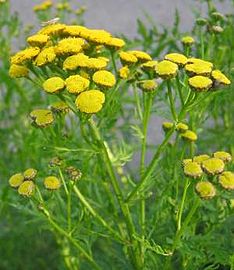
Tansy is a perennial herb and a member of the aster family, Asteraceae, that also includes daisy, yarrow, and lettuce. It is native to Europe and Asia but was introduced into North America by colonists before 1631 for medicinal and horticultural purposes and now occurs throughout much of the US in recently disturbed sites such as roadsides, railroad right of ways, hedgerows, ditches, vacant lots, old fields, pastures, and river banks. The plant has an extensive spreading root system composed of fibrous roots and rhizomes, and grows one to four feet tall. It has a thick upright stem that may be hairy or hairless, and is branched at the top. The green leaves are fern-like, six to eight inches long, and give off a pungent odor when crushed. They are pinnately compound and leaflets have toothed margins. The button-like flower heads are 1/2 inch wide and appear in summer in terminal flat-topped clusters. Each flower head consists of yellow disc flowers with ray flowers absent or reduced. The fruit is a single seeded achene and a single plant can produce up to 50,000 seeds that remain viable in the soil for just one season. Plants like well-drained soil with full or partial sun in USDA Hardiness Zones 3-8. The genus name Tanacetum was derived from the Greek word athanasia meaning immortality. The specific epithet, vulgare, comes from the Latin word vulgaris, meaning common. Photo Credit Wikipedia
The ancient Greeks believed that tansy could give immortality but it was also used by later civilizations to induce abortions, increase fertility, prevent miscarriages and treat a variety of problems from gout and worms to freckles, and pimples. Perhaps a more practical use of tansy was as a strewing herb to mask bad odors in the home as it was crushed underfoot, and it has been used in both the home and the garden to control insect pests. John Evelyn, the 17th century writer liked tansy in stir fry with spinach, primrose leaves, violets, and green corn but tansy is toxic and of limited culinary use.